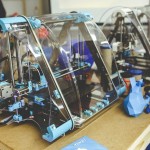The high cost and technical difficulty of making product prototypes have long been roadblocks for small business owners seeking to innovate. Lacking the deep R&D pockets of their large corporate brethren, how was a small business owner supposed to compete and bring new ideas to market? Fortunately, over the past decade, a solution has been found for this perennial dilemma. Fab labs, short for fabrication laboratories, have spread up around the world, putting digital fabrication within financial reach of small businesses and significantly simplifying the process of prototype development.
The idea of fab labs grew from an educational outreach program that MIT’s Center for Bits and Atoms began in 2001 with a National Science Foundation grant. Since then, a collaborative network of fab labs has grown up around the world. Fab labs offer a technical prototyping platform for innovation and invention and are a major boon to entrepreneurs just starting out and to existing small businesses pursuing product innovation. Thanks to fab labs and advent of 3D printing and similar technologies have made it possible for inventors and innovators to produce prototypes more easily than ever before.
And here is the really good news. The whole premise of fab labs is to democratize access to the tools for personnel expression and invention. Thus, to be part of the official Fab Lab Network, each fab lab must be open to the public for free or for in-kind services/barter at least part of each week. Talk about lowering the cost of getting in the game with your new product idea!
What resources are available to you at a fab lab? Fab Lab Network members operate off the principle that they should share a common set of tools and practices; this makes it possible for people throughout the extensive global network to collaborate. The network’s recommended list of capabilities include: a laser cutter for making 3D structures from 2D designs, a large CNC mill for making furniture and housing, a NC knife and smaller mini-mill for making circuits and molds for casting, 3D printers, an electronics workbench, and a suite of tooling and materials that allow anyone to make almost anything. And that will be the bare minimum you’ll find at your nearby fab lab. How’s that for significantly making it simpler for you to develop a new product prototype?
Over the past decade numerous community colleges and other organizations across the nation have opened fab labs. A list of fab labs is available through fablabs.io. As of last month (Sept. 2015) 107 fab labs were operating across the U.S., so you should be able to find one not far from you. You can also find more information about fab labs via the Fab Foundation and from the United States Fab Lab Network.

